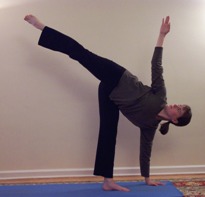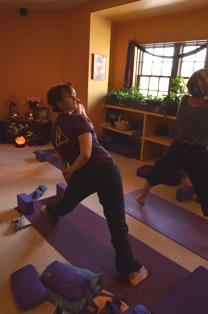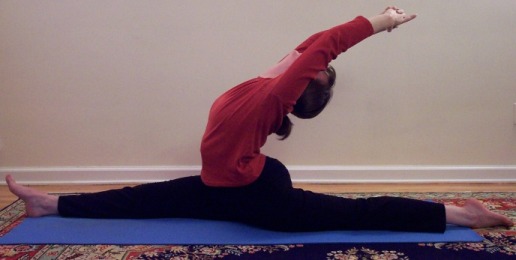Yoga Therapy
Yoga is a “potent tool of... health promotion.”
(Singh, 1986, p.67)
Yoga therapy connects you to your own natural healing capacity, meets you where you are, and supports self-regulation and resilience. From the perspective of yoga philosophy, dis-ease and illness fundamentally stem from separation/disconnection. The yogic model of health addresses every aspect of life rather than considering each body part or system separately. Although all yoga can be therapeutic, stress-relieving and healing, yoga therapy involves the use of the full spectrum of yoga practices and principles to address your physical, mental, emotional, energetic and spiritual needs. These may include yoga postures and flows (asanas), breathwork (pranayama), visualization and concentration practices (dharana), meditation techniques (dhyana), cleansing practices (kriyas), sound vibration and mantra, lifestyle examination, devotional practices (bhakti) and more. We may use yoga postures or movement–and for some this may be vigorous–but yoga therapy can also be used if you cannot move at all or if you have significant limitations in movement. Most importantly, yoga supports your own innate healing potential.
Yoga practice promotes physical and mental health, through “the maximization of joy and the complete unfolding of the human potential” (Ramaswami, 1989, p. 53). The definition of ideal psychological health proposed by yoga psychology is enlightenment, awakening, or realization. Health is seen as more than being free of symptoms, or adjusting and compromising to life’s constraints and difficulties. Yoga promotes physical and mental health, rather than being curative medicine or seeking physical wellbeing alone (Singh, 1986). In fact, the word “yoga” is derived from the Sanskrit root yuj, which means to yoke, bind, unite, join, or harness. Yoga can be seen as a philosophy and practice of connection, as we integrate all aspects of self and develop a sense of relatedness to other people, other beings, the environment, and the universe. Yoga develops your connection to self by supporting awareness of the links between mind, body, breath, feelings, memories, experiences, health, and states of consciousness. The techniques of yoga aim to uncover and highlight these connections.
Yoga therapy is a professional and tailored treatment to promote health and well-being within a therapeutic relationship with a certified yoga therapist. It includes personalized assessment, goal-setting, lifestyle management, and yoga practices. Yoga therapy aims to work with the natural inclination of the body and mind to move toward optimal well-being, health and healing. As a yoga therapist (informed by years of training and experience as a psychologist), I work with you to assess your needs, keep you safe, address your specific goals while considering any limitations you might experience, and increase your health and wellbeing.
Yoga begins with the body and the breath, but also develops the mind, awareness and concentration, and levels of consciousness. Yoga practices are one way to integrate work with the body, the breath, emotions, thoughts, interpersonal relationships, self-acceptance, healthy lifestyle choices, and self-awareness (emotionally, physically, mentally, socially, and spiritually/existentially). In addition to bodily changes, yoga practices involve behavioral, cognitive, and affective changes. Yoga has been shown to affect the nervous system by improving the ability to self-regulate, affecting the mind and body bidirectionally. For example, the mind affects the body through the use of cognitive tools like meditation and visualization, and the body affects the mind through movement and breathing techniques that change the state of the nervous system and affect thoughts and emotions. Yoga supports self-awareness, self-inquiry (svadhyaya) and insight. Yoga may help cultivate and strengthen healthy attitudes and behavior such as mindfulness, compassion, focus, generosity, equanimity, joy, and ethical behavior, thereby changing your relationship to others, the environment, and the universe. Yoga may support you in remaining present and coping with anxiety, tension, anger, negative memories, and conflicts. In a world where stress is so prevalent, and in which so many illnesses are related to stress, yoga practices can help reduce physical and mental tension. Although we are surrounded by messages to avoid pain and to seek pleasure and gratification, yoga may help support you to be present with what is.
Yoga can be a powerful tool when words fail or are inadequate: a way to shift patterns, awareness or energy if you have more difficulty expressing yourself or if traditional (talk) therapy has only gone so far. We are beings with bodies and experiences that are sometimes difficult to describe through language. Emotions and sensations are often embodied–and sometimes encapsulated–in physical experiences. Some people may be blocked or struggling with powerful physical reactions and memories, such as those evoked by trauma, eating disorders, anxiety, or medical concerns. Physical work can support you in feeling more accepting of and comfortable in your body, or in addressing problematic reactions to your body and bodily functions. Yoga practices encourage health by promoting suppleness, strength, endurance, and balance. Relaxation, deep breathing, and the release of physical tension helps us feel better, be more self-aware, and alter our perspectives and patterns. One of the goals of physical practices is to gain perspective on the body by gaining distance from it, fostering neutral observation and promoting higher levels of growth (Rama, Ballentine, & Ajaya, 1976). As the body releases tension and postures become effortless, the mind becomes calmer. Mental concentration and focused attention result and one naturally becomes more introspective, allowing access to intuition and one’s inherent wisdom.
Because the breath is both a voluntary and involuntary function (regulated by mind and body), it can be considered an intermediary between mind and body (Morse, Cohen, Furst, & Martin, 1984). The rhythm of the breath is often one of the most obvious physical indications of a person’s emotional and mental state. Although mental and emotional states often feel difficult to control, the irregularities of the breath can be easily observed and controlled. Yogic breathing exercises (pranayama) teach awareness of the breath, healthy breathing, and concentration. The breathing practices also teach one to be aware of and to control energy shifts.
In addition to promoting physical health, the physical yoga practices release tension and calm the body. The breathing and concentration practices calm both the body and mind, increasing focus and naturally promoting meditation. The mental and physical benefits of meditation practices, such as mindfulness meditation, have been very well documented. Many mental health practitioners already incorporate meditation into treatment. Yoga practices involving the physical body, the breath, and concentration prepare practitioners for meditation. Meditation ultimately leads to the experience of higher states of consciousness. This transpersonal consciousness – in which awareness is manifested as intuition and wisdom – must be directly experienced (Rama et al., 1976). The “witness consciousness” results in great bliss, joy, and peace. Ultimately, the practices involve the experience of universal awareness, in which the distinction between subject and object (knower and known) dissolves.
As described above, many physical and mental health goals are identical to those of yoga practice: promoting wellness and a strong, flexible body and mind, regaining a sense of peace and joy, balancing physical, mental, and energetic imbalances, creating cognitive, behavioral, and affective change, promoting introspection and self-awareness, coping with difficult experiences and mental states (e.g., anxiety), and developing self-acceptance and connection with others. There are also elements of yoga practice that are beyond the realm of traditional therapies, such as discussion of higher consciousness, integrated work with the physical body, energy body, breath and mental experience, and the felt-experience of the “witness consciousness.”
For some extra information on yoga therapy, please visit:
How Can Yoga Therapy Help?
Research on yoga therapy and health
Ware, C. J. (2007, June). Yoga and psychotherapy. Yoga Therapy in Practice, 15-17.
Yoga is based in a number of “principles” that promote health and a healthy outlook:
-
• There is wisdom in experiencing, in being. There is wisdom in your experience.
-
• You are just right as you are. You have likely forgotten this; all you have to do is remember or realize it.
-
• Your body-mind is just right the way it is; you are full of light.
-
• Yoga (union) is your natural state. We are all interrelated. If everything is connected, you can watch the body-mind-breath to understand the self, the universe, and your relationship to the universe.
-
• Change is inevitable. Everything can and will change, including your body, your thinking patterns, your lifestyle, and your breath. Yoga helps prepare for change when and as it occurs. Yoga teaches you to be mindful of the transitions in life.
-
• Yoga practices can help you become more aware of your body, breath, mind, spirit, and your link to the universal.
-
• You are different from your thoughts. Your mind is usually filled with continually changing thoughts, images, internal commentary, and fantasies. It is possible to observe your thoughts if you cultivate the ability to separate yourself from them. Although you are likely to initially experience your identity as a stream of thoughts, emotions, and urges, you will eventually witness the stream of consciousness. This is the experience of the observer, the witness, or the witness-consciousness. Eventually, both the witness and that which is witnessed will dissolve into the experience of pure consciousness.
-
• Yoga practices bring you into the present. Breath and movement are your connection to the present moment.
-
• Yoga practices bring calm, peace, and happiness to the moment.
-
• Yoga helps you accept difficulties, accept pleasure and pain. Yoga helps you experience relaxation in action – living life as free of tension as possible.
-
• Yoga encourages moderation (e.g., eating until you are satisfied; neither eating too much nor too little; eating in a way that is healthy for your body and questioning assumptions that we have about this)
-
• Yoga teaches you to be “where you are,” physically, mentally, spiritually. Rather than pushing, “flow.” Witness your experience – thoughts, feelings, sensations. Do that for which you are ready. Postures are not the goal – but mindfulness and flow.
-
• In terms of hatha yoga: you will feel better if you physically strengthen, stretch, cleanse, and stabilize your body (muscles, joints, spine, skeletal system, internal organs, glands, and nerves). You will feel better if you learn to tune in to your energy level and internal energy flow (prana). Yoga practices will help you revitalize, control, and enhance your energy. Meditation and concentration practices will increase your positive thinking, mental clarity, and focus. A conditioned, healthy body that holds as little tension as possible will help you be mindful, rest and watch the mind/breath, and sit in meditation more easily. The body moves to help calm the mind. The movement is also a point of focus for the mind, creating “meditation in motion.
A number of reported health benefits of yoga:
Increases/improves
Attention span/concentration
Cognitive/academic performance
Interpersonal skills/relationships
Calmness (quiets the mind)
Quality of life/wellbeing
Relaxation of body
Creativity
Respiratory operations
Coping with medical problems
Self-esteem
Assertiveness
Body and sensory awareness

Self-control/discipline
Mental alertness
Learning readiness/capacity
Balance/coordination
Flexibility
Strength
Respect for others, self, body
Ethical behavior/awareness
Peacefulness/conflict resolution
Emotional awareness/control

Decreases
Anxiety/Depression
Stress/tension
Hyperactivity and impulsivity
Posttraumatic stress
Anger
Mental activity
Physiological arousal
Cholesterol
High blood pressure
Chronic pain
Substance use/abuse
Asthma/allergies
Headaches
Test anxiety
Disruptive behavior
Phobic reactions
Shyness
Fatigue
Nightmares/sleeping problems/insomnia
Helps regulate
Blood pressure
Heart rate
Metabolic rate
Brain waves
Body temperature
Skin sweating
Energy/mood fluctuations
Sleep patterns
Digestion/assimilation/elimination
Supports coping with and adapting to
Healthy aging
Cancer
Diabetes
Heart disease and stroke
Parkinson's disease
Multiple sclerosis (MS)
Traumatic brain injury (TBI)
Arthritis
Premenstrual syndrome (PMS)
Fibromyalgia
Chronic fatigue syndrome
References:
Morse, D.R., Cohen, L., Furst, M.L., & Martin, J.S. (1984). A physiological evaluation of the yoga concept of respiratory control of autonomic nervous system activity. International Journal of Psychosomatics, 31, 3-19.
Rama, Swami, Ballentine, R., & Ajaya, Swami. (1976). Yoga and Psychotherapy: The Evolution of Consciousness. Honesdale, PA: Himalayan International Institute of Yoga Science and Philosophy.
Ramaswami, S. (1989). Yoga and healing. In Sheikh, A.A. & Sheikh, K.S. (Eds.), Healing East and West: Ancient Wisdom and Modern Psychology (pp.33-63). New York: John Wiley & Sons.
Singh, R.H. (1986). Evaluation of some Indian traditional methods of promotion of mental health. Activitas nervosa superior, 28, 67-69.

Please note: yoga practitioners, medical and mental health professionals, researchers, and the public are increasingly aware of the health benefits of yoga practice, including stress-reduction, physical benefits, and mental health benefits. Although yoga is not a substitute for professional medical, psychological and psychiatric care, many doctors and professionals agree that yoga practices greatly benefit their clients in a number of important ways. Yoga is a holistic practice that integrates and develops the mind, body, breath, and spirit. For some, yoga practice may be an important or essential adjunctive treatment, complementing standard care. For others, the integration of yoga practices and traditional care may enhance benefits and promote healing.
![]()
